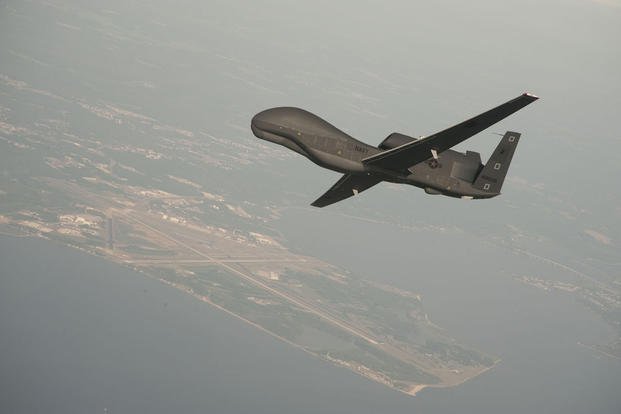A U.S. surveillance drone that has a higher price tag than an Air Force F-35 Joint Strike Fighter jet and is capable of collecting vast amounts of data was shot down by Iran in what military officials are calling an unprovoked attack in international airspace.
The aircraft, a Navy RQ-4A Global Hawk, was taken out by an Iranian surface-to-air missile system Wednesday night. Iranian reports that the aircraft was over Iran are false, Navy Capt. Bill Urban, U.S. Central Command spokesman, said in a statement.
"U.S. Central Command can confirm that a U.S. Navy Broad Area Maritime Surveillance (or BAMS-D) ISR aircraft was shot down by an Iranian surface-to-air missile system while operating in international airspace over the Strait of Hormuz at approximately 11:35 p.m. GMT on June 19, 2019," Urban said. "This was an unprovoked attack on a U.S. surveillance asset in international airspace."
Related content:
-
Iran Fired Missile at US Drone Prior to Tanker Attacks: Defense Official
-
Plan to Deploy 1,000 More Troops to Counter Iran Faces Growing Opposition
The Global Hawk is an unmanned system used by the Air Force and Navy that's capable of flying intelligence, surveillance and reconnaissance missions at high altitudes. In 2015, the aircraft, which can fly long distances over water and along coastlines, cost $123 million, according to Defense Department budget documents. That's about $34 million more than the cost of the latest block of F-35A Lightning II aircraft, the Pentagon's next-generation fighter jets.
The incident comes days after U.S. officials say Iranians fired a surface-to-air missile at an American MQ-9 Reaper drone and occurred near where officials say Iranians attacked a pair of tankers near the Strait of Hormuz, a vital waterway where much of the world's oil traffic occurs.
The military last month dispatched a Navy aircraft carrier strike and amphibious ready groups along with B-52 Stratofortress bombers, citing credible threats in the region. Pentagon officials announced this week that another 1,000 troops will head to the Middle East for "defensive purposes to address air, naval and ground-based threats in the Middle East."
The loss of a Global Hawk drone isn't one the U.S. will shrug off, Ulrike Esther Franke, a drone scholar and policy fellow with the European Council on Foreign Relations, said via Twitter on Thursday. It's the world's biggest drone system -- a flying "data hoover," she added, filled with high-tech equipment.
"This drone was specifically designed to be largely invulnerable -- because it flies so extremely high," Franke wrote, adding that the loss of the aircraft will hurt the U.S. "quite a lot."
Northrop Grumman, which makes the Global Hawk, began testing its latest suite of sensors for the drone in 2017. Company officials told Military.com at the time that the sensor has about a 100-mile range.
Shooting down a Global Hawk would be tough since it flies at upward of 65,000 feet, according to The Drive, an automobile and technology news site.
"This would have been a sophisticated radar-guided surface-to-air missile that shot the aircraft down, not a shoulder-fired, heat-seeking missile," The Drive reported.
Military.com in 2017 observed RQ-4 Global Hawks at Al Dhafra Air Base in the United Arab Emirates. The base has a handful of Global Hawks, some belonging to the Navy, which vary in capability.
In 2014, an RQ-4 Block 40 variant, which tracks radar and moving targets, beat records when it undertook a 34.3-hour flight, marking the longest unrefueled flight by an Air Force aircraft, according to service officials.
It's not clear from where the shot-down Navy RQ-4 originated.
The Air Force lost a Global Hawk last year when the RQ-4 broke apart and crashed after its navigation system caused it to fly too high and too fast. Pieces of the drone ended up in an unpopulated area of California.
-- Gina Harkins can be reached at gina.harkins@military.com. Follow her on Twitter @ginaaharkins.
-- Oriana Pawlyk can be reached at oriana.pawlyk@military.com. Follow her on Twitter @Oriana0214.













